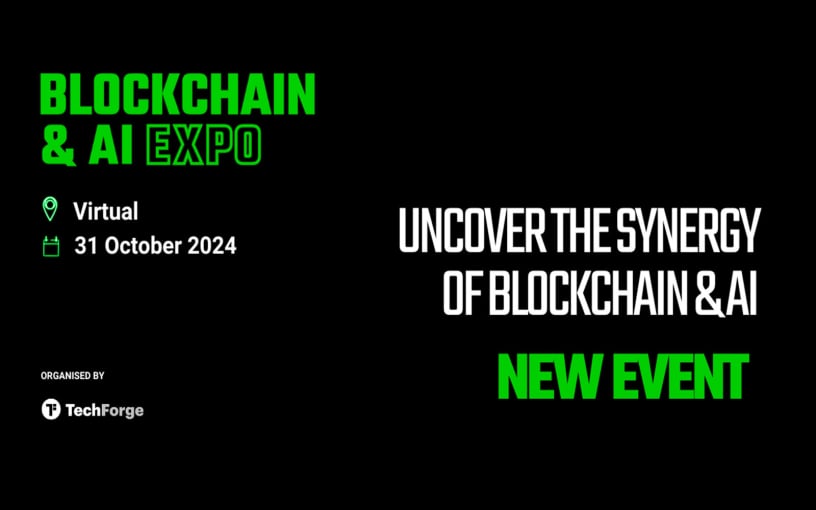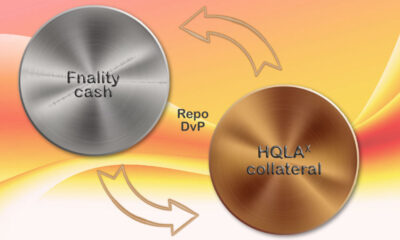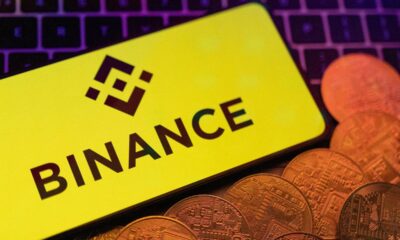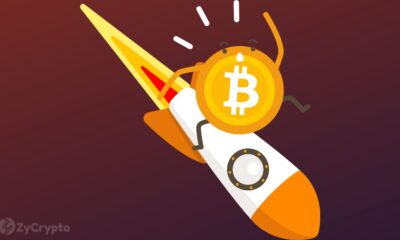News
Why I Changed My Mind About Blockchain

I studied cryptography in college around the same time that Bitcoin was emerging as a new and unconventional concept. In one of my courses we analyzed the cryptographic building blocks of a cryptocurrency very similar to Bitcoin. While I admired the brilliance of the algorithms and protocols, I wasn’t particularly thrilled with them blockchain technology. My main reservation was that, despite its innovative design, it didn’t solve any problems that I personally found significant.
My skepticism about blockchain continued until a few months ago, when I collaborated with one of Aerospike’s recent clients, the BSV Association. It uses blockchain to elegantly solve an engineering challenge that, as far as I know, has not been effectively addressed elsewhere, especially not so easily: the creation of an unlimitedly and linearly scalable core banking system.
I chose to use “mainstream banking” instead of “cryptocurrency” to avoid the various connotations associated with the latter term. For this discussion, we can think of a cryptocurrency simply as a system that allows customers to create accounts, deposit, withdraw, and transfer funds, functions that mirror those of traditional core banking systems.
In my opinion, core banking systems represent quintessential examples of complex, mission-critical, secure, and precise applications that, despite considerable effort, have consistently resisted modernization.
The Unmodernizables
Many major banking systems are unscalable or scale inefficiently, forcing financial services firms to expend significant resources and effort on only minimal increases in workload capacity. Typically, these scalability limitations arise from a reliance on relational database management systems (RDBMS), such as mainframes or Oracle, which inherently lack the necessary scalability.
Upgrading the heart and soul of major banking systems from RDBMS to scalable, faster, more convenient and efficient NoSQL databases has proven to be extremely challenging. This is largely due to the inherent characteristics of RDBMSs, which are ideal for building complex systems. However, several applications initially developed using a relational approach have managed to successfully transition to NoSQL.
During the transition from RDBMS to NoSQL, the data storage layer inevitably loses some key characteristics while gaining others. These lost features are critical to the functionality of the application and cannot be overlooked. Therefore, it is essential to address the absence of these capabilities within the application layer, which is why migrating highly complex mission-critical systems away from RDBMS is so difficult.
Additionally, RDBMS operations are supported by mathematical proofs, providing unbreakable guarantees of data integrity, even in the presence of application-level bugs. In contrast, in the NoSQL realm, the highest authority is a dude who tests databases for a living (with all due respect). The most it can say is that no bugs were found in the tested version of a technology. Clearly, this level of assurance is insufficient for critical environments such as major banking systems. Therefore, if we intend to abandon the mathematical guarantees offered by the relational model, we must implement similar guarantees within the application layer.
One method to obtain these guarantees is through formal methods. However, given the complexity of core banking systems, building one using only this approach is very challenging.
The potential of Blockchain
Getting the buzzwords out of the way, Blockchain is basically a mathematically proven method zero trust algorithm. Therefore, it can be implemented in the application layer to compensate for the lack of mathematical guarantees in the underlying storage model. Furthermore, the success of Bitcoin proves that blockchain technology can indeed be used effectively to build a central banking system.
However, Bitcoin and numerous other blockchain-based cryptocurrencies are significantly limited by their transaction volume, which is considerably lower than that of traditional non-scalable financial transaction systems. As a result, in this particular aspect, existing cryptocurrencies do not offer substantial improvements over traditional financial systems.
BSV’s Solution to Blockchain Throughput Challenges
Without going into too much detail, the limited throughput of blockchain-based cryptocurrencies mainly stems from this the size of blockchain blocks. For example, the block size of the most famous implementation of White Paper on Bitcoin, Bitcoin, is limited to 1MB, limiting it to processing just seven transactions per second, an embarrassingly low figure. On the contrary, the Bitcoin Cash the implementation managed to increase throughput to over 100 transactions per second by increasing the block size to 32 MB, although this number also remains disappointingly low.
Bitcoin Satoshi Vision, or BSV for short, is another implementation of the Bitcoin White Paper. The main design goal of BSV is to overcome throughput limitations by eliminating the block size cap, theoretically allowing unlimited throughput. However, this modification represents a substantial engineering challenge.
Cryptocurrencies created based on the Bitcoin White Paper use the Unspent transaction output (UTXO), unlike the traditional accounting model used in core banking systems. UTXO information is retrieved and updated in the UTXO store to check whether a Bitcoin transaction can be spent. Any delays in processing a UTXO would significantly reduce the performance of a Bitcoin node, resulting in a loss of revenue for miners.
To speed up this process, it is essential that UTXOs are accessible as quickly as possible. Storing UTXOs in memory would provide the speed needed for efficient operations. However, this approach comes with significant cost implications: millions of transactions per second translate into trillions of UTXOs, requiring tens of terabytes of RAM. Such high resource demands could make the solution prohibitively expensive, posing a major barrier to widespread adoption and scalability.
Aerospike: the key to BSV’s scalable future
Using commodity solid state drives instead of RAM for data storage as Aerospike significantly reduces BSV costs associated with maintaining UTXOs in fast data storage, ensuring efficiency and affordability, which in turn promotes Wider network adoption.
It is important to note that the consistency and integrity of the UTXO storage is crucial for the proper functioning of the node. If the UTXO store becomes corrupted, the node will not be able to successfully participate in revenue generation activities for several cycles, resulting in unwanted but limited damage. Therefore, BSV nodes rely on Aerospike’s Strong Consistency mode to mitigate this risk.
However, the overall correctness of the protocol, including the accuracy of balances and transfers, which could cause unlimited damage if corrupted, relies on strong mathematical guarantees provided by the blockchain at the application level.
Overcoming Barriers: Unprecedented Transaction Capabilities
In the testing phase, the BSV network demonstrated that it can do this support 1 million transactions per second for a long period (weeks). In comparison, the Visa payment system can handle up to 65,000 transactions per second.
To handle 1 million transactions per second, each BSV node, known as a Theranodeit generates about 3 million requests per second on its Aerospike cluster, a significant but modest number compared to other customers.
For example, Criteoa renowned French advertising technology company, uses Aerospike to handle 280 million requests per second, indicating that neither Aerospike nor block size would be a limiting factor in scaling the BSV network.
In a parallel universe
Over the past decade I have assisted several financial institutions in adapting their systems to new use cases, such as mobile banking and regulatory compliance initiatives such as Bank open. A recurring theme in these projects is the implementation of solutions to improve the productivity limits of the underlying systems. In a previous articleI have explained extensively why such approaches are incredibly inefficient.
Typically, these solutions use a scalable database that retrieves data from a non-scalable RDBMS through a complex extract, transform, and load (ETL) process. While these systems increase workload capacity, they require substantial investments in new infrastructure, require millions of hours of engineering work, and result in the creation of complex systems that are difficult to maintain. This is what I call inefficient scaling.
I can imagine a parallel universe in which central systems are unlimitedly and linearly scalable. In such a world, accommodating a new use case that increases demand on the core system could be handled simply by expanding existing infrastructure. There would be no need to build systems whose sole purpose is to protect the weakest link. No increasing complexity. No multi-year, billion-dollar projects just to launch an app.
It is this vision that changed my mind about blockchain.
Learn more about Aerospike’s highly scalable millisecond latency real-time database.
YOUTUBE.COM/THENEWSTACK
Technology moves fast, don’t miss an episode. Subscribe to our YouTube channel to stream all our podcasts, interviews, demos and more.
SUBSCRIBE
Group created with Sketch.
Behrad Babaee is a technology evangelist at Aerospike. He has designed several applications that you could use on a daily basis. He is interested in the non-functional attributes of data-intensive applications such as performance, scalability, availability and efficiency. Behrad uses the vast ability and experience of him…
Read more from Behrad Babaee
News
Blockchain Technology Will Transform Water Access and Management Globally

Disclosure: The views and opinions expressed here are solely those of the author and do not represent the views and opinions of the crypto.news editorial team.
Access to clean water is a basic human need, yet billions of people around the world still struggle to get it. According to the World Health Organization, over 2 billion people live in countries suffering from severe water stress, and this number is expected to continue to grow due to climate change and population growth.
Traditional water management systems have struggled to address these challenges, often hampered by inefficiencies, lack of transparency, and misallocation of resources. Blockchain technology offers a promising solution to these challenges, providing equitable access and sustainable use of this crucial resource.
The current state of water management
Water management today faces several pressing issues. Inefficiencies in water supply, distribution, and use, coupled with a lack of real-time monitoring, often result in resource waste and misallocation. Many water sources fail to realize their full potential due to infrastructure and financing shortfalls. For example, the Environmental Protection Agency (EPA) report indicated that the United States would need to invest $625 billion over the next 20 years to repair, maintain and improve the country’s drinking water infrastructure due to aging pipes and other infrastructure problems. Additionally, in the United States alone, household leaks can to waste nearly 900 billion gallons of water per year nationwide. This is equivalent to the annual domestic water consumption of nearly 11 million homes.
Furthermore, corruption and mismanagement of water resources can cause unequal distribution, with disadvantaged communities often bearing the brunt of water scarcity. For example, South Africa is struggling with myriad challenges to its water security: drought, inadequate water conservation measures, outdated infrastructure, and unequal access to water resources. The country faces significant water scarcity, with demand expected to outstrip supply by 2030, creating a projected gap of 17%.
Furthermore, the global water industry is highly monopolized, with a few key players controlling a significant share of the market. These companies exert substantial influence over the water supply chain, often prioritizing profit over equitable distribution and environmental responsibility. This concentration of power can lead to inflated prices and limited access for vulnerable populations. The global bottled water market alone is projected to reach $509.18 billion by 2030, with these large companies capturing a significant share of revenue. This monopolization exacerbates existing inequalities in water access and highlights the need for more decentralized and community-driven water management solutions.
Source: Grand View Search
The potential of blockchain in water management
Blockchain technology can address these issues by providing a transparent, secure, and decentralized platform for water resource management. This approach offers several advantages:
- Transparency and accountability. Blockchain’s immutable ledger ensures that all transactions and data entries are transparent and cannot be changed once recorded. This transparency can reduce corruption and ensure that water resources are allocated fairly and efficiently. For example, blockchain can be used to track water usage from source to end user, providing a clear record of how water is distributed and used. This level of transparency can help hold authorities accountable and manage water resources sustainably.
- Efficient resource management. Blockchain can facilitate the creation of smart contracts, which are self-executing contracts with the terms of the agreement written directly into the code. These contracts can automate water distribution based on real-time data, directing water to where it is needed most. For example, smart contracts could be used to manage urban water supply systems, automatically adjusting water distribution based on real-time consumption patterns and demand. This can help optimize water use, reduce waste, and ensure that households and businesses receive the right amount of water at the right time.
In Dubai, the Dubai Electricity and Water Authority (DEWA) has implemented a blockchain-based smart water network initiative as part of its broader smart city strategy. This project integrates blockchain technology with IoT sensors to monitor water usage in real time, manage distribution, and detect leaks. The decentralized ledger ensures data integrity and transparency, enabling more efficient water management and reduced waste. DEWA’s initiative aims to improve sustainability and resource management in the rapidly growing city, highlighting the potential of blockchain to support urban water management and conservation efforts.
Community participation and ownership
Through blockchain, individuals can directly control and monetize their access to water resources, eliminating the need for third-party intermediaries. This direct control model allows local communities to make collective and transparent decisions about their water use. By managing their water directly from the source, communities can tailor water management practices to their specific needs, promoting equitable distribution and encouraging a sense of accountability and stewardship.
Additionally, future models could allow people to monetize their access to water through web3 technologies. For example, a community-to-business (C2B) model could allow people to sell water directly to companies. In this model, people do not have to own the water directly, but can profit by staking their tokens during event sales pools. This approach not only supports sustainable water management, but also creates economic opportunities for community members. Additionally, a “Burn to Secure” protocol can be used to provide water allocation rights. This protocol provides a true sense of water security and financial opportunity by allowing people to redeem their rights. This system not only secures future water allocations, but also increases token scarcity and value.
Additionally, a pure sense of investment is achieved through investments in water sources. This leads to potential financial returns and dividends by addressing the inefficiencies in water supply mentioned above. By investing to finance infrastructure projects, such as building factories and improving distribution systems, more water can be brought to communities, creating additional economic opportunities.
Monetizing water access through the C2B model, the “Burn to Secure” protocol, and investments in water sources all generate economic benefits for the community, promoting a more equitable and efficient water management system.
Overcoming challenges
While blockchain technology has the potential to improve water management, there are challenges to its adoption. The complexity of blockchain systems and the need for technological infrastructure can be barriers, especially in developing regions. Additionally, there are concerns about the significant energy consumption of blockchain networks. However, technological advances and the development of more energy-efficient blockchain solutions are helping to alleviate these concerns. Additionally, education and capacity building are key to ensuring stakeholders understand how to effectively use blockchain technology. Governments, NGOs, and private sector partners need to work together to provide training and support to communities and water management authorities.
Blockchain technology offers a practical and effective means to improve water management. In addition to addressing inefficiencies, blockchain empowers communities, promotes sustainable practices, and opens up new economic opportunities through models like community-to-business (C2B). As we face the growing challenges of climate change and population growth, blockchain is not only an innovative solution, but represents a fundamental shift in the way we manage and value water resources. Adopting blockchain in water management is essential to creating a sustainable and equitable future by changing the way we interact with and protect our most vital resource.

Jean-Hugues Gavarini
Jean-Hugues Gavarini is the CEO and co-founder of LAKE (LAK3), a real-world asset company leveraging blockchain technology to decentralize access to the global water economy. LAKE aims to ensure access to clean water for all, protect water resources, and deliver water to those in need through innovative technologies. Jean-Hugues has a diverse career spanning the luxury, fashion, and footwear industries. His career path includes notable successes at Mellow Yellow, Cremieux, and Tod’s. Raised between Silicon Valley and the French Alps, Jean-Hugues has always been immersed in technology and freshwater resources. In 2018, Jean became the CEO of Lanikea Waters, a water solutions entity based in the French Alps. In 2019, the concept of LAKE was born, embodying his commitment to innovation and sustainability.
News
Blockchain and AI Expo 2024

With rapid advances in the world of AI and blockchain, there are opportunities to leverage the security and transparency features of blockchain to improve the reliability and trust of AI systems and data transactions.
Explore the synergy of these advanced technologies in virtual mode Blockchain and AI Expowhich takes place on October 31, 2024 TO 10:00 GMT.
The event features cutting-edge presentations led by leading experts in evolving fields. Presentations are set to explore opportunities and challenges in the fusion of blockchain and AI, real-world applications, ethics, innovations in environmental sustainability, and more!
Gain a comprehensive understanding of how these technologies can synergistically drive innovation, optimize operations, and promote strategic growth opportunities. Develop your knowledge to facilitate informed decision making and give your company a competitive edge in the growing technology landscape.
News
Nigeria Eyes National Blockchain Nigerium for Data Sovereignty

Nigeria is keeping an eye on a new native blockchain network to protect the country’s data sovereignty.
According to local media, a team from the University of Hertfordshire has proposed the new blockchain, Nigeriato the National Information Technology Development Agency (NITDA).
Chanu Kuppuswamy, who leads the team, argued that relying on blockchain networks whose developers are located in other regions poses national security risks to the Nigerian government. He further said that Nigerium would allow the West African nation to customize the network to meet specific needs, while also promoting data sovereignty.
In his presentation, Chanu cited the recent migration of Ethereum to test of participation (PoS) consensus as an instance in which no Nigerians were involved but whose impact is far-reaching.
“Developing an indigenous blockchain like Nigerium is a significant step towards achieving data sovereignty and promoting trust in digital transactions in Nigeria,” he said.
While receiving the proposals in Abuja, NITDA’s Kashifu Abdullahi acknowledged the benefits a local blockchain would bring to Nigeria, including increased security of citizens’ data.
However, a NITDA spokesperson later clarified that Nigerium is still at the proposal stage and that the government has not yet decided whether to proceed or not.
“The committee is still discussing the possibility with stakeholders. Even if a decision is finally made, there is no guarantee that the name will be Nigerium,” the spokesperson told the media.
Nigerium’s reception in the country has been mixed. Some, like financial analyst Olumide Adesina, To say the network is “dead on arrival”. He believes the Nigerian government’s poor record in following through on its big technology plans will claim another victim. He pointed to the eNaira as a missed opportunity whose chances of success were much higher than those of Nigerium.
Others welcomed the proposal. Chimezie Chuta, who chairs the renewed The Nigerian Blockchain Policy Committee is “extremely optimistic“that Nigerium will be more successful than eNaira.
Speaking to a local news agency, Chuta stressed that eNaira failed because the central bank initiated the project on its own, without involving any stakeholders.
“They just cooked it and expected everyone to like it. [With Nigerium]there will be a lot of collaboration,” he said.
Registration of property title, digital identity and Certificate Verification are among the use cases that Nigerium is expected to initially target. However, Nigeria has already made progress in some of these fields through public blockchains.
SPPG, a leading school in governance and politics, announced in May the country’s first blockchain certificate verification system. Built on the The BSV BlockchainIt was developed in collaboration with the blockchain data recording company VX Technologies and local lender Sterling Bank.
Watch: The Future Has Already Arrived in Nigeria
 Italian: https://www.youtube.com/watch?v=M40GXUUauLU width=”560″ height=”315″ frameborder=”0″ allowfullscreen=”allowfullscreen”>
Italian: https://www.youtube.com/watch?v=M40GXUUauLU width=”560″ height=”315″ frameborder=”0″ allowfullscreen=”allowfullscreen”>
New to blockchain? Check out CoinGeek Blockchain for Beginners section, the definitive guide to learn more about blockchain technology.
News
Cambodian CBDC Developer to Build Palau Bond Market on Blockchain: Report

A Japanese fintech developer will build a blockchain-based bond market gateway for Palau, aiming to launch a trial in 2024 and a full launch the following year.
Japanese fintech developer Suramitsubest known for developing a central bank digital currency (CBDC) for Cambodia, is intended to build a Blockchain-gateway to the bond market based on the Pacific island nation of Palau, Nikkei He learned.
Soramitsu won the contract and plans to introduce the market on a trial basis in fiscal 2024, with a full launch scheduled for the following year, allowing the Palauan government to issue bonds to individual investors and efficiently manage principal and interest payments, according to the report.
The total cost of the project is estimated at several hundred million yen ($1.2 million to $5.6 million), less than half the cost of a non-blockchain alternative, people familiar with the matter said. The project has reportedly received support from Japan’s Ministry of Economy, Trade and Industry, with Japan’s foreign and finance ministries providing strategic and management advice on the project.
Soramitsu’s successful development of Cambodia’s CBDC in 2020 has boosted its reputation, with the digital currency’s popularity soaring, with over 10 million accounts opened by December 2023, representing 60% of Cambodia’s population. Following this, Cambodia’s central bank governor Chea Serey indicated intends to expand the reach of its CBDC internationally, particularly through collaboration with UnionPay International, the Chinese card payment service, and other global partners.
While Soramitsu’s work in Cambodia has been well received, the long-term popularity of CBDCs remains to be seen. As of late June, crypto.news reported a sharp drop in activity in India’s digital currency, the e-rupee, after local banks stopped artificially inflating its values.
According to people familiar with the matter, the Reserve Bank of India managed to hit the 1 million retail transaction milestone last December only after the metrics were artificially infiltrated by local banks, which offered incentives to retail users and paid a portion of the bank’s employees’ salaries using the digital currency.
-

 News1 year ago
News1 year ago“Captain Tsubasa – RIVALS” launches on Oasys Blockchain
-

 Ethereum1 year ago
Ethereum1 year agoComment deux frères auraient dérobé 25 millions de dollars lors d’un braquage d’Ethereum de 12 secondes • The Register
-

 News1 year ago
News1 year agoSolana ranks the fastest blockchain in the world, surpassing Ethereum, Polygon ⋆ ZyCrypto
-

 Videos1 year ago
Videos1 year agoHistoric steps for US cryptocurrencies! With a shocking majority vote!🚨
-

 Videos1 year ago
Videos1 year agoIs Emorya the next gem💎 of this Bitcoin bull run?
-

 News1 year ago
News1 year agoSolana Surpasses Ethereum and Polygon as the Fastest Blockchain ⋆ ZyCrypto
-

 Videos1 year ago
Videos1 year agoNexus Chain – Ethereum L2 with the GREATEST Potential?
-

 Ethereum1 year ago
Ethereum1 year agoScaling Ethereum with L2s damaged its Tokenomics. Is it possible to repair it?
-

 News1 year ago
News1 year agoFnality, HQLAᵡ aims to launch blockchain intraday repositories this year – Ledger Insights
-

 Regulation1 year ago
Regulation1 year agoFinancial Intelligence Unit imposes ₹18.82 crore fine on cryptocurrency exchange Binance for violating anti-money laundering norms
-

 Bitcoin1 year ago
Bitcoin1 year agoBitcoin Drops to $60K, Threatening to Derail Prices of Ether, Solana, XRP, Dogecoin, and Shiba Inu ⋆ ZyCrypto
-

 Videos1 year ago
Videos1 year agoRaoul Pal’s Crypto Predictions AFTER Bitcoin Halving in 2024 (The NEXT Solana)










